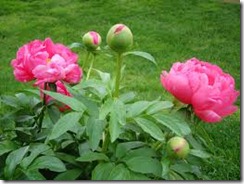Peonies produce a mop-headed, drooping flower and fingered leaves that brush along the ground. Frustrated gardeners wait all winter and into the spring for that first bloom of the peony to unfurl, often to be greeted with white mold or brown spots on the foliage. Good sanitation practices as well as basic knowledge of peony problems will help keep your peony plant looking lovely.
Blight
-
Botrytis cinerea, the fungus responsible for the most common peony blight, can affect major plant parts. Rainy, overcast conditions promote spread of botrytis blight, manifesting in early spring. By the time they are 6 inches tall, young plants are vulnerable to yellowing base foliage and stems, resulting in a plant that falls over. Moldy-looking spots with a hairy surface on brown buds often accompany botrytis blight. Block botrytis fungus attacks with preventative measures. Avoid watering in the late evening or early morning and water at the plant’s base, not over the leaves.
Leaf Blotch
-
Spots and blotches on peony create a concern for gardeners as they can affect not only the overall appearance of the plant but also the buds and thus future flowers. Red spots are generally the obvious symptom for leaf and stem spot fungus, sometimes enlarging to a grey center with red edges or merging together into irregularly shaped masses on purple leaves with brown undersides. Proper removal of old, dead material and general good sanitation practices should eliminate leaf blotch issues. Remove dead material immediately and destroy it, separate from your compost pile.
White Mold
-
A stem-rotting fungus, Sclerotinia sclerotiorum can affect more than just your peonies if it enters the soil. Close examination of the sliced interior of an infected plant stem reveals decay and dark structures that harbor the fungus over winter. White, cottony mold appears on the plant’s surface in humid conditions. Carefully remove infected plants and the soil communicating with them to ensure the fungus does not return.
Wilt
-
Herbaceous plants wilt when verticillium fungus enters the water vessels in the stem of the plant. The plant may wilt above ground, showing no symptoms of distress around its base. In this case, University of Minnesota Extension master gardeners suggest contacting a local university extension office to positively identify the fungus. Once verticillium invades the soil, it is virtually impossible to kill. Destroy the infected plant and take care in placing a plant in the previously infected soil.
Virus
-
Various disorders caused by diseases can affect the health and appearance of peonies. Leaf curl and light and dark patterned spotting known as mosaic cause visible distress to foliage even though the plant may bloom as normal. Decide whether the infection warrants discarding the plant based on severity of symptoms.


Deprecated: strpos(): Passing null to parameter #1 ($haystack) of type string is deprecated in /home/agriviek8Qv/agriviet.net/public_html/wp-includes/comment-template.php on line 2522